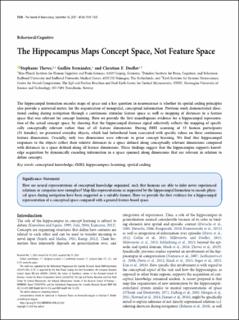| dc.contributor.author | Theves, Stephanie | |
| dc.contributor.author | Fernández, Guillén | |
| dc.contributor.author | Doeller, Christian Fritz Andreas | |
| dc.date.accessioned | 2021-09-01T12:43:08Z | |
| dc.date.available | 2021-09-01T12:43:08Z | |
| dc.date.created | 2020-11-25T14:47:24Z | |
| dc.date.issued | 2020 | |
| dc.identifier.citation | Journal of Neuroscience. 2020, 40 (38), 7318-7325. | en_US |
| dc.identifier.issn | 0270-6474 | |
| dc.identifier.uri | https://hdl.handle.net/11250/2772278 | |
| dc.description.abstract | The hippocampal formation encodes maps of space and a key question in neuroscience is whether its spatial coding principles also provide a universal metric for the organization of nonspatial, conceptual information. Previous work demonstrated directional coding during navigation through a continuous stimulus feature space as well as mapping of distances in a feature space that was relevant for concept learning. Here we provide the first unambiguous evidence for a hippocampal representation of the actual concept space, by showing that the hippocampal distance signal selectively reflects the mapping of specifically conceptually relevant rather than of all feature dimensions. During fMRI scanning of 32 human participants (21 females), we presented everyday objects, which had beforehand been associated with specific values on three continuous feature dimensions. Crucially, only two dimensions were relevant to prior concept learning. We find that hippocampal responses to the objects reflect their relative distances in a space defined along conceptually relevant dimensions compared with distances in a space defined along all feature dimensions. These findings suggest that the hippocampus supports knowledge acquisition by dynamically encoding information in a space spanned along dimensions that are relevant in relation to define concepts. | en_US |
| dc.language.iso | eng | en_US |
| dc.publisher | Society for Neuroscience | en_US |
| dc.rights | Navngivelse 4.0 Internasjonal | * |
| dc.rights.uri | http://creativecommons.org/licenses/by/4.0/deed.no | * |
| dc.title | The Hippocampus Maps Concept Space, Not Feature Space | en_US |
| dc.type | Peer reviewed | en_US |
| dc.type | Journal article | en_US |
| dc.description.version | publishedVersion | en_US |
| dc.source.pagenumber | 7318-7325 | en_US |
| dc.source.volume | 40 | en_US |
| dc.source.journal | Journal of Neuroscience | en_US |
| dc.source.issue | 38 | en_US |
| dc.identifier.doi | 10.1523/JNEUROSCI.0494-20.2020 | |
| dc.identifier.cristin | 1852310 | |
| cristin.ispublished | true | |
| cristin.fulltext | original | |
| cristin.qualitycode | 2 | |

